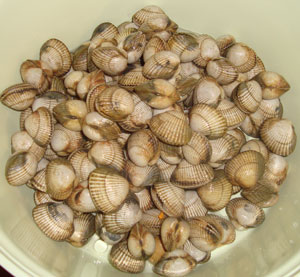Clams Ahoy!
Everything you always wanted to know about Clams but were afraid to ask!!
Common Cockle - Cerastoderma Edule
A great tasting Cockle
Cockles are common worldwide with over 200 species living primarily in sheltered sandy areas. Cockle shells are distinctive with their symmetric, heart shaped, and ribbed appearance (although egg cockles are smooth). Not all cockles taste good, but the Common Cockle, Cerastoderma edule, is tasty and commonly eaten in Europe.
Sometimes it may be called the Common European Cockle as cockles are common in many areas. Seafood vendors often use the name cockle generically to refer to any cockle shaped shellfish such as the venus clams and ark clams.
The picture is of a bunch of common cockles, called coques in French, bought at a large supermarket about 100 miles South of Paris.
They range from the Barents Sea, north of Norway, to Senegal in the South, and from east to west from Norway to Ireland. They are very common and abundant bivalves, which in part accounts for their popularity and low price. They are also farmed in many areas, including in the Netherlands, Portugal, and Britain.
 They are shallow water creatures and commonly harvested by
raking on tidal flats. This is hard work and can be dangerous - people have
died - as on some of these flats the tidal range can be extreme. For example
on the Bay of Saint-Brieuc in Brittany the tidal range can be almost 13 meters on
spring tides.
They are shallow water creatures and commonly harvested by
raking on tidal flats. This is hard work and can be dangerous - people have
died - as on some of these flats the tidal range can be extreme. For example
on the Bay of Saint-Brieuc in Brittany the tidal range can be almost 13 meters on
spring tides.
Common cockles can jump up to 5 inches by kicking with their foot, and easily distinguished by their numerous eyes and antennae. They are also great fishing bait and an important food for many types of marine life, including many species of fish, crustaceans, and birds.
Cooking cockles is easy and they can be cooked as any other clam, and yes, they are clams. A favorite British seaside cockle recipe is boiled and seasoned with white pepper and malt vinegar, usually purchased from seaside stalls. My British friends sometimes refer to these as Hot Cockles, although that is also the name of an old children's Christmas game. They are also common pickled, which I've never tried, both in jars and sealed pouched with included fork as a quick snack. They are also used whole in shell in pasta dishes as the ones pictured above were. In Wales, they are commonly served for breakfast fried with bacon and with laverbread, a gelatinous paste made by boiling seaweed for hours and then mincing it.
Your mileage may vary with other types of cockles. For example the cockles native to Cape Cod Massachusetts taste horrible! In the words of Clam Hooting Skipper John, "unpleasant, offensive taste something like Brussels sprouts. They are bitter . . . They are awful."
However, the common cockle or Cerastoderma Edule is inexpensive, widespread in much of Europe, and delicious.
 Hi,
we are Ted and John, just two guys who love Clams and other seafood.
Hi,
we are Ted and John, just two guys who love Clams and other seafood.